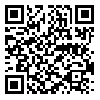Volume 23, Issue 3 (September 2025)
Iranian Rehabilitation Journal 2025, 23(3): 351-358 |
Back to browse issues page
Download citation:
BibTeX | RIS | EndNote | Medlars | ProCite | Reference Manager | RefWorks
Send citation to:



BibTeX | RIS | EndNote | Medlars | ProCite | Reference Manager | RefWorks
Send citation to:
Hussein Abed F, Jihad S K. Anxiety Levels Among Patients Following Ischemic Stroke: A Cross-sectional Study. Iranian Rehabilitation Journal 2025; 23 (3) :351-358
URL: http://irj.uswr.ac.ir/article-1-2541-en.html
URL: http://irj.uswr.ac.ir/article-1-2541-en.html
1- Department of Mental and Psychological Health, College of Nursing, University of Babylon, Hillah, Iraq.
2- Department of Community Health, College of Nursing, University of Babylon, Hillah, Iraq.
2- Department of Community Health, College of Nursing, University of Babylon, Hillah, Iraq.
Abstract: (1246 Views)
Objectives: This study aimed to quantify anxiety levels among post-ischemic stroke patients in Babylon Governorate, Iraq, and establish a correlation between anxiety severity and sociodemographic/clinical factors.
Methods: A cross-sectional study was conducted among 100 post-ischemic stroke patients at Al-Imam Al Sadiq Teaching Hospital and Babylon Specialized Medical Rehabilitation Center (October 2024–July 2025). Anxiety severity was quantified using a modified Hamilton rating scale for anxiety (HAM-A) as mild (70–116.66), moderate (116.67–163.33), and severe (163.34–210). Sociodemographic (income, education, sex, and age) and clinical data (chronic illness and smoking status) were collected through structured interviews. The relationship between variables was examined using multivariate logistic regression and chi-square tests to identify predictors of severe anxiety.
Results: Patients aged >65 years also had disproportionately high rates of severe anxiety (32.4%) compared to their younger counterparts (15.6%), as indicated by a statistically significant chi-square analysis (χ2=8.12, P=0.043). Financial instability was also a cause of higher anxiety, with 37.5% of patients who had “insufficient” income reporting severe anxiety versus only 15.4% of patients who had “sufficient” income (P=0.012). Clinically, patients with chronic comorbidities were 3.2 times more likely to experience severe anxiety (odds ratio [OR]=3.21, 95% CI, 1.45%, 7.12%, P=0.004), indicating the comorbidity of physical and psychological distress. The level of education was also significant: 28.6% of illiterates experienced severe anxiety compared to 13.6% of those with diploma and above levels (P=0.041).
Discussion: The high prevalence of moderate-to-severe anxiety (87.2%) is consistent with global trends and highlights the need for universal mental health screening in post-stroke patients. Independent predictors, such as advanced age, low income, and a high burden of chronic disease, identify vulnerable subgroups that require targeted interventions. The majority of sample post-ischemic stroke patients experienced moderate levels of anxiety, about a quarter of the sample had severe anxiety, and about half of the sample had mild anxiety.
Methods: A cross-sectional study was conducted among 100 post-ischemic stroke patients at Al-Imam Al Sadiq Teaching Hospital and Babylon Specialized Medical Rehabilitation Center (October 2024–July 2025). Anxiety severity was quantified using a modified Hamilton rating scale for anxiety (HAM-A) as mild (70–116.66), moderate (116.67–163.33), and severe (163.34–210). Sociodemographic (income, education, sex, and age) and clinical data (chronic illness and smoking status) were collected through structured interviews. The relationship between variables was examined using multivariate logistic regression and chi-square tests to identify predictors of severe anxiety.
Results: Patients aged >65 years also had disproportionately high rates of severe anxiety (32.4%) compared to their younger counterparts (15.6%), as indicated by a statistically significant chi-square analysis (χ2=8.12, P=0.043). Financial instability was also a cause of higher anxiety, with 37.5% of patients who had “insufficient” income reporting severe anxiety versus only 15.4% of patients who had “sufficient” income (P=0.012). Clinically, patients with chronic comorbidities were 3.2 times more likely to experience severe anxiety (odds ratio [OR]=3.21, 95% CI, 1.45%, 7.12%, P=0.004), indicating the comorbidity of physical and psychological distress. The level of education was also significant: 28.6% of illiterates experienced severe anxiety compared to 13.6% of those with diploma and above levels (P=0.041).
Discussion: The high prevalence of moderate-to-severe anxiety (87.2%) is consistent with global trends and highlights the need for universal mental health screening in post-stroke patients. Independent predictors, such as advanced age, low income, and a high burden of chronic disease, identify vulnerable subgroups that require targeted interventions. The majority of sample post-ischemic stroke patients experienced moderate levels of anxiety, about a quarter of the sample had severe anxiety, and about half of the sample had mild anxiety.
Article type: Original Research Articles |
Subject:
Nursing
Received: 2025/05/1 | Accepted: 2025/06/11 | Published: 2025/09/1
Received: 2025/05/1 | Accepted: 2025/06/11 | Published: 2025/09/1
Send email to the article author








